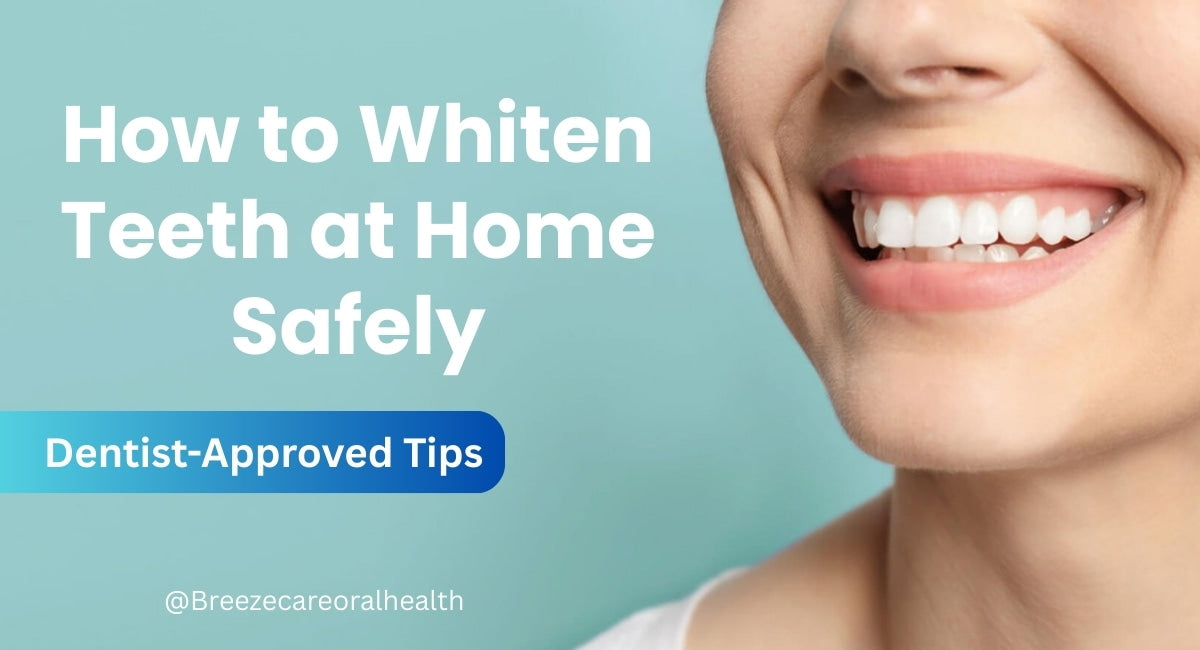A bright, confident smile never goes out of style. It’s often one of the first things people notice, and many of us want to keep our teeth looking as white as possible.
While professional whitening treatments can offer fast results, they’re not always affordable or accessible for everyone. That’s why many Australians are turning to at-home teeth whitening options.
But with so many DIY solutions and over-the-counter products available, how do you know what’s safe and what could harm your teeth?
You can safely whiten your teeth at home if you stick to dentist-approved methods and avoid harsh DIY trends that can harm your enamel. The right approach will brighten your smile while keeping your teeth healthy and strong.
In this guide, we break down what dentists recommend when it comes to whitening your teeth at home, without compromising your oral health.
Why Do Teeth Get Stained?
Understanding the root cause of discolouration can help you choose the best whitening method. Common culprits include:
-
Drinking coffee, tea, red wine or soft drinks
-
Smoking or using tobacco products
-
Poor oral hygiene
-
Natural ageing
-
Certain medications or medical treatments
Teeth have a porous outer layer called enamel. Over time, pigments from food and drinks can seep into these tiny pores, leading to yellowing or dullness.
Can You Safely Whiten Your Teeth at Home?
Whitening your teeth at home can seem like an easy fix, but it’s not always risk-free. While some over-the-counter products and DIY methods do work, many can harm your enamel or irritate your gums, especially when overused or used incorrectly.
The safest approach? Choose dentist-approved treatments that protect your oral health while delivering real results.
Dentist-Approved Ways to Whiten Teeth at Home
Rather than trying every new trick trending on social media, focus on methods that are supported by dental professionals. Here’s what dentists typically recommend for safe, at-home teeth whitening:
1. Use Whitening Toothpaste Carefully
Whitening toothpastes contain gentle abrasives and mild bleaching agents like hydrogen peroxide. While they won’t dramatically change the colour of your teeth overnight, they can help remove surface stains when used consistently.
Look for products approved by dental associations in Australia and avoid overbrushing, as too much abrasion can wear down enamel.
2. Try Over-the-Counter Whitening Strips (with Caution)
Whitening strips are thin, flexible plastic strips coated with a peroxide-based gel. They’re easy to use and widely available. However, using them too often or leaving them on for too long can lead to sensitivity.
Always follow the product’s instructions and consider taking breaks between treatment cycles to protect your teeth.
3. Baking Soda (Occasionally)
Baking soda has natural whitening properties and is a mild abrasive, helping to scrub away surface stains. But it should only be used sparingly. Applying it too often or too vigorously can erode your enamel over time.
Mix a small amount with water to form a paste and brush gently once a week—no more.
What to Avoid When Whitening at Home
Several popular DIY trends sound promising, but can do more harm than good:
-
Lemon juice or apple cider vinegar: Highly acidic and can damage tooth enamel quickly.
-
Charcoal toothpaste: Often too abrasive and lacks sufficient scientific support.
-
Hydrogen peroxide rinses at high concentrations: May irritate gums and cause sensitivity.
These methods might provide temporary brightness but come with serious long-term risks.
How to Maintain Results with Good Habits
Whitening isn’t a one-time fix. Even the best at-home products won’t last long if you don’t adjust your daily habits. Here’s how to keep your smile brighter for longer:
-
Brush at least twice a day with fluoride toothpaste
-
Floss daily to remove plaque buildup between teeth
-
Rinse with water after consuming stain-causing drinks like coffee or wine
-
Use a straw to reduce contact with staining liquids
-
Book regular dental check-ups and cleans
Consistency in oral care makes a significant difference in both the appearance and health of your teeth.
What to Do If You Experience Sensitivity
Mild sensitivity is common during whitening treatments. If your teeth become sore or sensitive:
-
Stop the whitening treatment for a few days.
-
Switch to toothpaste designed for sensitive teeth.
-
Avoid very hot or very cold foods and drinks.
-
Talk to your dentist if symptoms persist.
Over-the-counter desensitising gels can also help ease discomfort.
When to See a Dentist
While at-home options are useful, they may not be suitable for everyone. Deep stains, dental restorations or underlying oral health issues may require a professional approach.
You should consult a dentist if:
-
Your teeth have uneven colour or dark spots
-
You have crowns, veneers or fillings in visible areas
-
You experience pain or gum irritation during whitening
-
You want faster and more dramatic results
At BreezeCare, we can help assess your smile and guide you to the safest whitening plan based on your individual needs.
Final Thoughts
Achieving a brighter smile from home is possible, but it requires patience, the right products and an understanding of your teeth’s limits. Whitening should never come at the cost of your oral health.
Stick with dentist-recommended treatments, avoid shortcuts and be mindful of how your teeth react. And remember, no matter how white your smile is, regular brushing, flossing and professional care are key to long-term oral wellness.
If you're unsure which whitening method is best for you, reach out to our team at BreezeCare. We’re here to help you smile with confidence safely.











